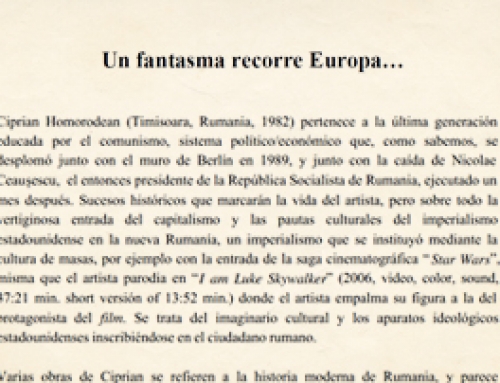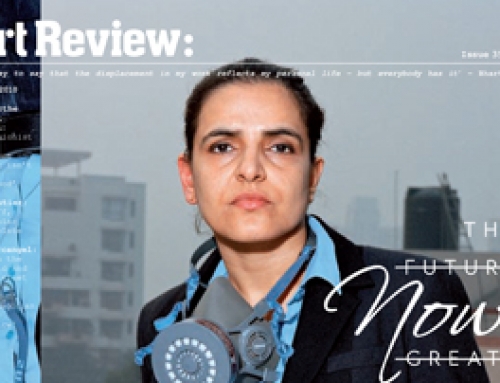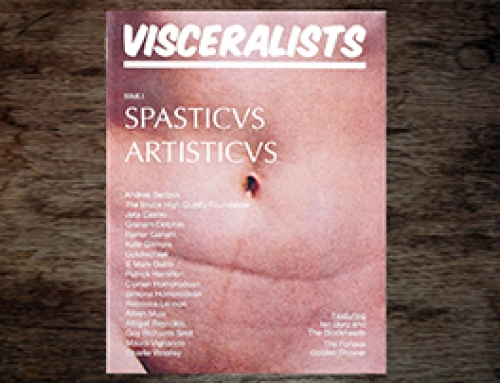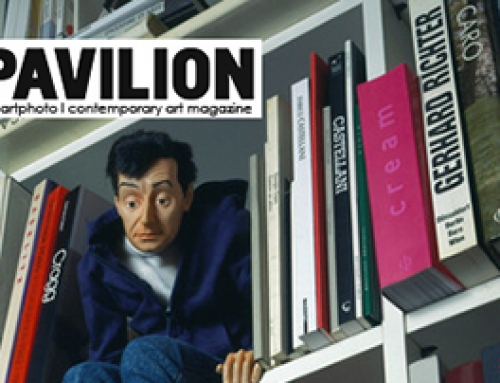by AYMARA ARREAZA R.
www.a-desk.org / 29 December 2015.
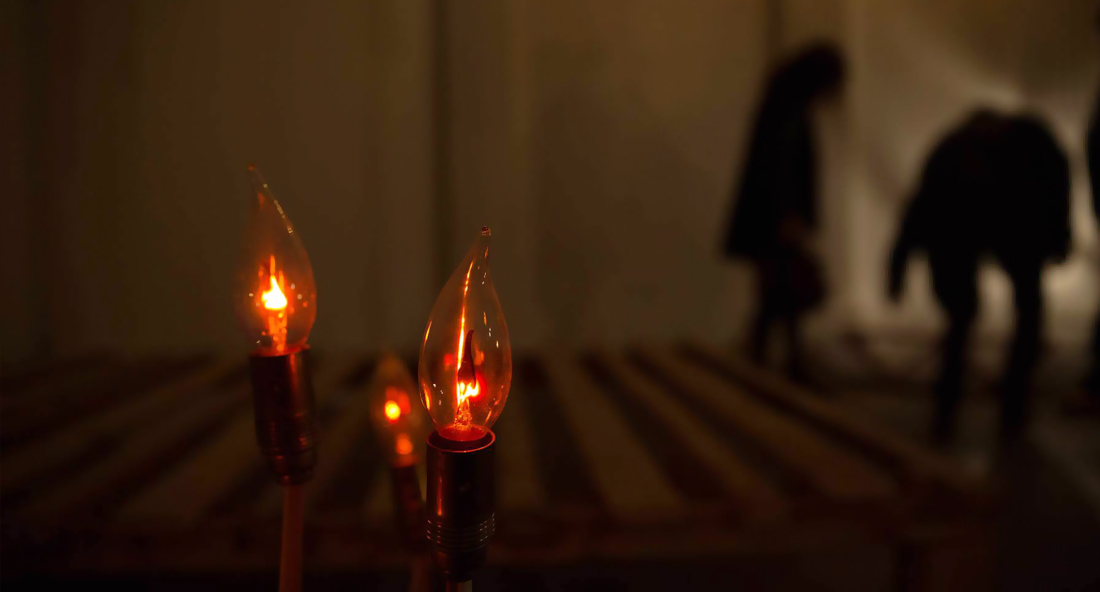
The reusing of recycled materials alludes to the essentials needed for rest or for the pleasure of eating but at the same time also manifest the importance the (de)construction of the found has for this artist. The pieces are the result, the final gesture, but are not the only ones to bear in mind. In this working process of the accumulation of experiences, one has to take into consideration the time from when Ciprian Homorodean first sets out on the trail, like a bloodhound, looking for materials to produce the minimally necessary in the rooms. To assemble the house, to think of the materials with which to model the chairs, the dining-room, the shelves… is also a way of distancing oneself from mere utility. According to the form and the place in which these are developed, they express the economic conditions and (dis)entrenchment of the occupants of a house.
A (desacralized) religious building, the chapel of Sant Roc is the place that houses the exhibition and becomes the backdrop for the questioning of the habitat. What is a home? Where is it situated? Is furniture fundamental for the habitation of a home? Are houses cupolas? Are there houses without roofs? With no roof but with a fire to huddle around? Let me add a question formulated by Marta Rosler in 1993; its validity dialogues and pays testimony to the relevance of what has been recounted until now: How do we know what home looks like?
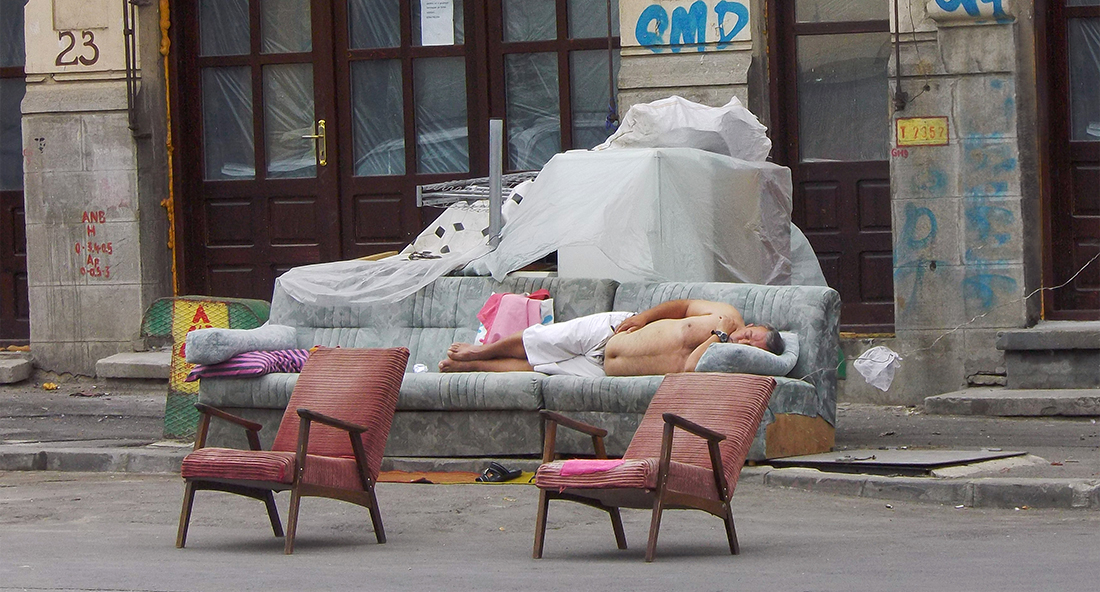
Hogar dulce hogar is a framework that questions and proposes how to inhabit the spaces we imagine, those given to us or those we are capable of constructing. It is also an echo: the constant repetition of dogs barking. The pack is on the prowl, watching perhaps over the belongings of their owners. Suddenly you hear a noise: Dogville is now in Valls. From here the howls propagate, escaping the religious salon converted into an exhibition space while simultaneously mingling with those of the dogs in the neighbourhood. In DogValls, the tensions I’ve referred from the start also focus on these sites of worship that could serve as places of shelter for refugees. Paradoxically some conform to being the scenarios for the provision of cultural tourism, exhibition spaces or as voting centres for presidential elections, as happened at the chapel of San Roc the day after the opening of Hogar dulce hogar. In short it would seem they are hiatuses that introduce microcosms of other forms of social experience: different layers of society sharing for instants the same roof.
Some of the pieces that Ciprian Homorodean concocted for personal use in his home in Barcelona are the ones he is showing in this exhibition that forms part of the Dèria cycle. Stripping the flat that provides him shelter to compose a new piece. The move generated a void in his family space. The removal of his personal furniture re-signifies and resituates it, placing in evidencing that this artist bears his house on his back. He can (un)pack wherever he has a place to deploy a site specific, like the one that fills the chapel of Sant Roc in Valls. Little by little he changes the domestic landscape as if it was a transposition in which the formal diversity makes material the argument of fragility or the mobility of the home. Hogar dulce hogar converts the exhibition hall into an authentic world; one incidentally, at the antipodes de of the homogeneity imposed by Ikea.
And to bring to an end this text, that aims not to be solely wallpaper for Ciprian Homorodean’s décor; a brief epilogue. The constant in Dèria is that the home is where the artist’s work is shown. The obsession driving him demonstrates the means with which to understand his creative process; the way the organisation of his artistic labours becomes a continuous action and critique. The home is where he places one of his pieces it is a bridge between thought, creation and managing life.
www.a-desk.org
Independent Institute of Criticism and Contemporary Art, is dedicated to training, editing & research on contemporary art criticism.
Español :
La reutilización de materiales reciclados alude a los enseres necesarios para ejercer el descanso o el placer de comer y, al mismo tiempo, manifiesta la importancia que tiene para este artista crear desde la (des)composición de lo encontrado. Las piezas son el resultado, el gesto final, pero no el único a tomar en cuenta. En este proceso de trabajo hecho por acumulación de experiencias hay que contar desde el momento en el que Ciprian Homorodean se moviliza y rastrea, como perro sabueso, los materiales para producir lo mínimamente necesario en las estancias. Armar la casa, pensar los materiales con los que se modelarán las sillas, el comedor, las estanterías… es también un modo de distanciarse de la mera utilidad. Según la forma y el lugar en el que estos se desarrollen, expresan la condición económica y de (des)arraigo de los ocupantes de una casa.
Un edificio religioso (desacralizado), la capilla de Sant Roc, es el recinto que acoge la exposición y se convierte en telón de fondo para cuestionar el hábitat. ¿Qué es una casa? ¿Dónde tiene lugar? ¿Son imprescindibles los muebles para habitar el hogar? ¿Casas con cúpulas? ¿Casas sin techos? ¿Sin techos pero con una hoguera a la cual arrimarse? Sumo una pregunta que se formuló Marta Rosler en 1993; su vigencia dialoga y pasa el testigo de relevo a lo relatado hasta ahora: How do we know what home looks like? (¿Cómo sabemos qué aspecto tiene un hogar?).
Hogar dulce hogar es un marco que cuestiona y propone cómo habitar los espacios que imaginamos o nos son dados, o somos capaces de construir para vivir. Es también un eco: la repetición constante de los ladridos de los perros. La jauría está al acecho, quizá atenta a las pertenecías de sus amos. De repente se oye un ruido: Dogville ahora está en Valls. Desde allí se propagan aullidos que salen del salón religioso reconvertido en espacio expositivo, al tiempo que se confunden con los de los perros del vecindario. En DogValls las tensiones a las que me refería desde el principio tienen el foco también en esos espacios de oración que podrían servir como casas de acogidas para refugiados. Paradójicamente algunas se conforman con ser los escenarios de las ofertas del turismo cultural, espacios expositivos o salas de votaciones para elecciones presidenciales, tal como sucedió con la capilla de Sant Roc el día siguiente de la inauguración de Hogar dulce hogar. En definitiva, pareciera que son paréntesis que introducen microcosmos de otras formas de experiencias sociales: diferentes estatus de la sociedad compartiendo por instantes el mismo techo.
Algunas de las piezas que confeccionó Ciprian Homorodean para uso personal en su actual domicilio de Barcelona son las que muestra en esta exposición que forma parte del ciclo Dèria. Despojó el piso que le da cobijo para componer una pieza nueva. El traslado generó un vacío en su espacio familiar. El desplazamiento de su mobiliario privado resignifica y reubica los muebles y pone en evidencia que este artista lleva la casa a cuestas. La puede (des)armar allí donde dispone de lugar para desplegar un site specific, como el que llena la capilla de Sant Roc en Valls. Poco a poco cambia el paisaje doméstico, como si fuese una trasposición en la que la diversidad formal materializa el argumento de la fragilidad o movilidad de la casa. Hogar dulce hogar convierte la sala de exhibición en un mundo auténtico; por cierto, en las antípodas de la homogeneidad impuesta por Ikea.
Y para el cierre de este texto que no pretende ser solo papel tapiz para el decorado de Ciprian Homorodean, un epílogo breve. La constante de esta dèria es que el hogar está donde se muestra el trabajo del artista. La obsesión que lo mueve demuestra el modo como entiende su proceso creativo; la manera de gestionar su labor artística se convierte en acción y crítica continua. El hogar está allí donde pone una de sus piezas, es un puente entre el pensamiento, la creación y la gestión de la vida.
